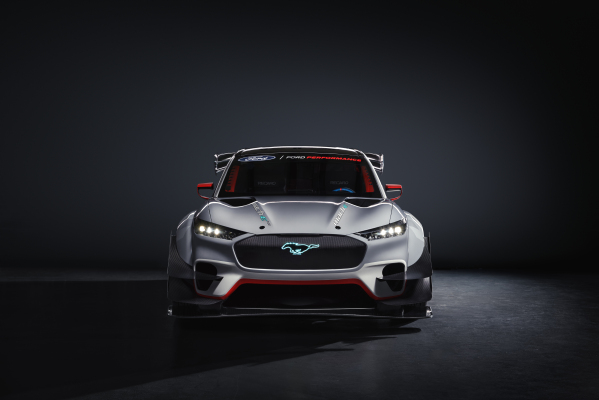Speed sells. When Tesla launches a new vehicle or updates an existing vehicle, the car company often leads with 0-60mph time. These numbers often outclass those from gasoline cars thanks to how electric motors deliver power. These 0-60 times are often irrelevant to daily driving, and yet, Tesla, like most automakers, sees them as a critical marketable statistic.
Ford today unveiled a special edition of its forthcoming four-door electric Mustang. It’s fast because, as mentioned above, speed sells. Seven electric motors produce a total of 1,400 HP, which to put into layman’s terms, is a shit-ton of power.
Ford doesn’t intend to sell this example. The car company says this vehicle was built to explore the limits of electric vehicle technology — and, clearly, to show it off to the public.
The upcoming Ford Mustang Mach-E will come in a performance trim called the GT. While it will only have two electric motors instead of seven, it won’t be a slouch. The two motors will produce 459 HP, which is plenty of power to thrill.
This is Ford’s second special edition Mustang Mach-E. The Mustang Cobra Jet was unveiled earlier this year, and sports 1,400 HP, but does so in a different configuration that’s primarily designed to go fast in a straight line.
These concept Mustangs build excitement from key demographics, much like how Tesla’s Insane and Ludicrous modes make excitement around its vehicles. Ford is in a tight spot with the Mustang Mach-E, and it needs to show buyers that this four-door electric vehicle is worth of the Mustang nameplate. And what are Mustangs known for? Affordable excitement.
The Mustang Mach-E is set to be Ford’s first modern electric vehicle, and so far, Ford is following a different path than General Motors when it launched its first electric vehicle, the Chevy Bolt. By all accounts, the Chevy Bolt is an excellent electric vehicle with a low price tag, decent range, and quick speed. But Chevy positioned it as a boring people mover. The Mustang Mach-E has similar people moving capacity, but Ford upped the excitement with the Mustang name and marketing the performance.
There’s an old automative adage that says says winning in races produces sales. “Win on Sunday, sell on Monday” spoke of a time when NASCAR vehicles were similar to their road-worthy counterparts. That’s no longer the case. NASCAR vehicles rarely share any parts with what’s available on a dealer’s lot, but the adage is still relevant. Instead of NASCAR, automakers are looking at winning in the world of YouTube, where views are as critical as a checkered flag.
Tesla’s first vehicle was a reworked Lotus coupe. At the time, most electric cars were designed for moving people and goods. They were utilitarian. The Tesla Roadster had little utility but had a lot of excitement. From there, Tesla moved onto the Model S and quickly built out its performance capability by adding duel motors and tuning them to beat a Porsche to 60 miles per hour. When launching Tesla’s Model X SUV, the automaker often showed it beating supercars in drag races, because, once again, speed sells even if owners rarely use the power.
[ad_2]
Source link


